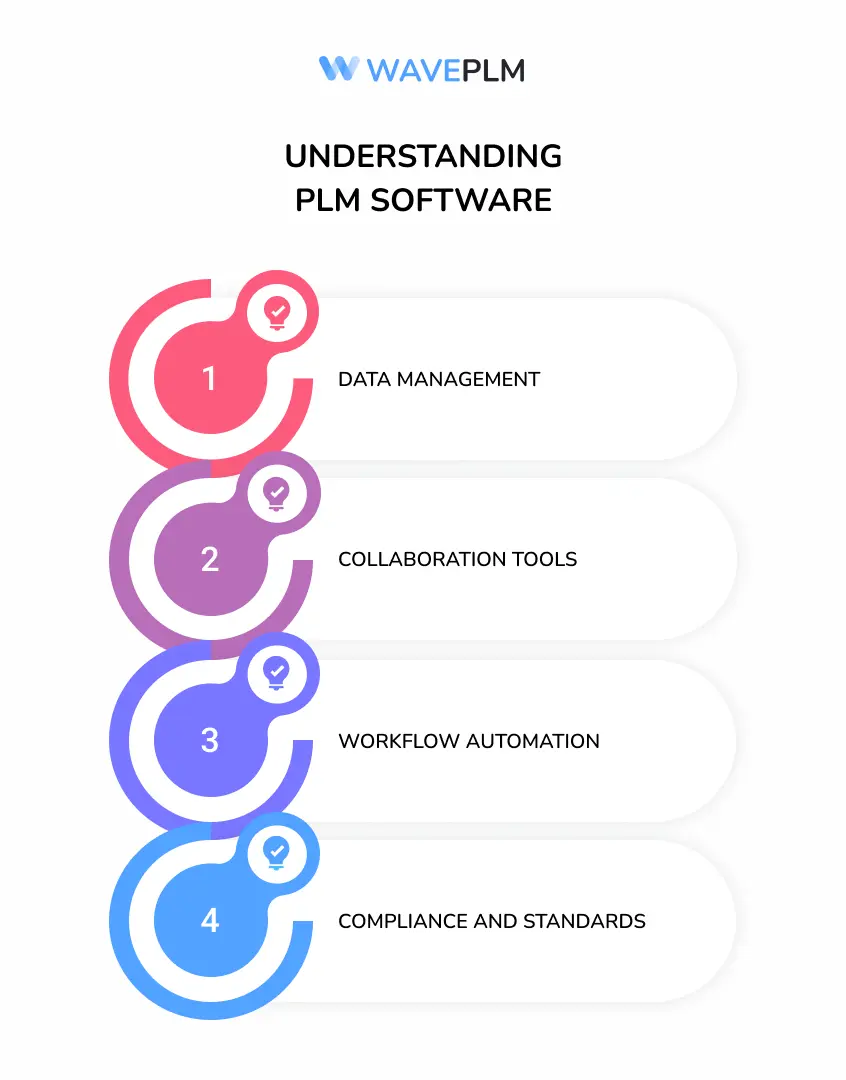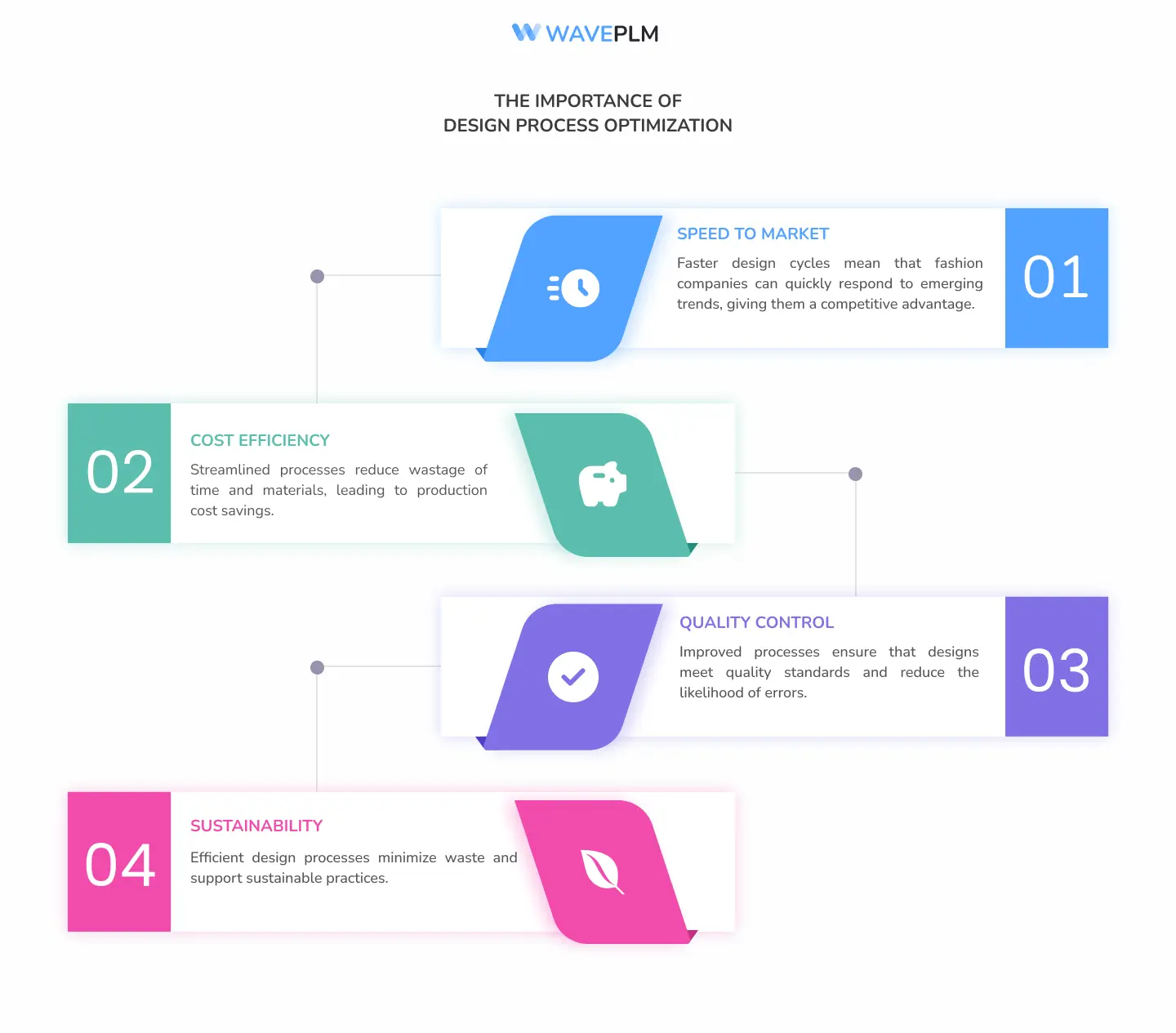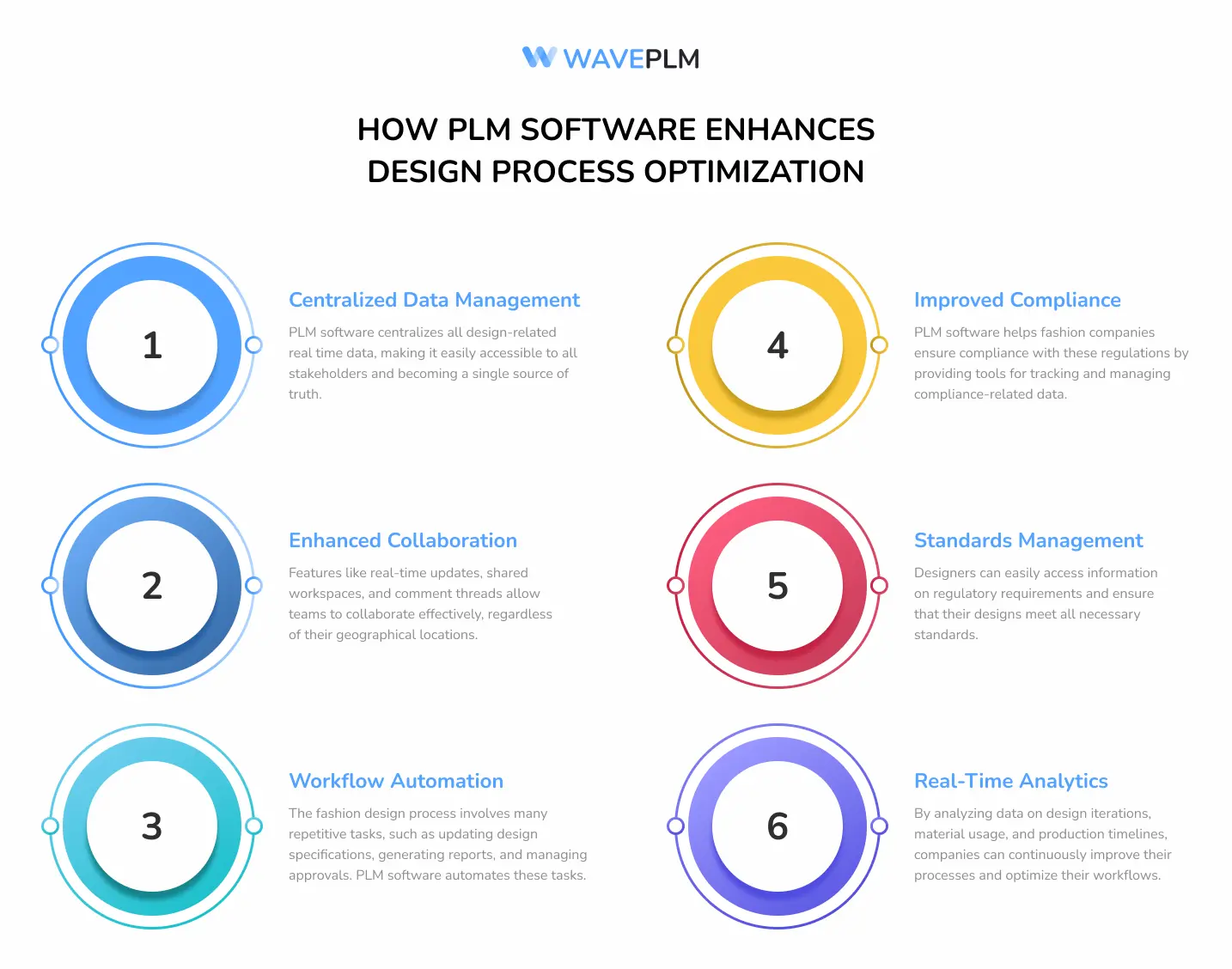
Optimize design process with fashion PLM
The fashion industry, particularly the apparel industry, is known for its fast-paced and ever-changing nature. With trends shifting rapidly, fashion companies must continually innovate to stay ahead. One of the most critical aspects of this innovation is the design process optimization.
In recent years, digital transformation has played a pivotal role in revolutionizing how fashion companies operate, and Product Lifecycle Management (PLM) software has emerged as a key tool in this transformation. This article explores how PLM software can optimize the design process in the fashion industry, making it more efficient, collaborative, and responsive to market demands.
Introduction to Optimization
Optimization in the fashion industry is all about streamlining production processes to achieve substantial cost savings, enhance operational efficiency, and meet ever-evolving market demands. The entire production process, from initial design to final distribution, can be fine-tuned to reduce waste, minimize energy consumption, and promote sustainable practices. By implementing an optimized supply chain, fashion companies can significantly improve production efficiency, reduce production costs, and enhance customer satisfaction.
Effective inventory management and stringent quality control are crucial components of this optimization. By ensuring that materials and products are available when needed and meet high standards, companies can avoid costly delays and rework. Additionally, sustainable practices, such as using eco-friendly materials and reducing waste, not only benefit the environment but also resonate with increasingly eco-conscious consumers. In essence, optimization in the fashion industry is about creating a more efficient, cost-effective, and sustainable production process that meets the demands of the modern market.
Understanding PLM Software
PLM software is a strategic approach to managing a product’s lifecycle, from initial concept through design, apparel manufacturing, and beyond. In the context of the fashion industry, PLM software helps manage the intricate details of product development, ensuring that designs are completed accurately, efficiently, and in line with market trends, which reduces cost. The core functionalities of PLM solutions include:
- Data Management: Centralizes all product-related data, including design files, materials, and specifications.
- Collaboration Tools: Facilitates communication and collaboration among designers, manufacturers, and other stakeholders.
- Workflow Automation: Streamlines processes by automating repetitive tasks and ensuring consistency.
- Compliance and Standards: Ensures that products meet industry standards and regulations.

The Importance of Design Process Optimization
The design process in the fashion industry is multifaceted and complex. It involves numerous stages, including research, conceptualisation (like mood boards), sketching, pattern making, prototyping (including the virtual prototyping we discussed before), and finalizing designs, which all together make up a digital transformation strategy. Optimizing this process is crucial for several reasons:
- Speed to Market: Faster design cycles mean that fashion companies can quickly respond to emerging trends, giving them a competitive advantage.
- Cost Efficiency: Streamlined processes reduce wastage of time and materials, leading to production cost savings.
- Quality Control: Improved processes ensure that designs meet quality standards and reduce the likelihood of errors.
- Sustainability: Efficient design processes minimize waste and support sustainable practices.
Optimizing the design process not only enhances efficiency but also drives business growth by enabling companies to respond quickly to market demands.

How PLM Software Enhances Design Process Optimization
PLM software offers numerous features that significantly enhance the design process. Here are some ways it contributes to design process optimization in the fashion industry:
PLM software ensures that efficiency is enhanced without compromising quality, maintaining high standards throughout the design process.
1. Centralized Data Management
One of the biggest challenges in the fashion design process is managing a vast amount of data. PLM software centralizes all design-related real time data, making it easily accessible to all stakeholders and becoming a single source of truth. This centralization ensures that everyone is working with the most up-to-date information, reducing the risk of errors and miscommunications. Centralized data management also helps in maintaining consistent quality by ensuring that all stakeholders have access to the same accurate information.
For instance, designers can quickly access material specifications, previous design iterations, and feedback from stakeholders, allowing them to make informed decisions without having to sift through disparate sources of information.
2. Enhanced Collaboration
Collaboration is vital in the fashion industry, where designers, manufacturers, suppliers, and marketers need to work closely together. PLM software provides a platform for seamless communication and collaboration. Features like real-time updates, shared workspaces, and comment threads allow teams to collaborate effectively, regardless of their geographical locations.
This enhanced collaboration leads to faster decision-making and ensures that all team members are aligned with the project’s goals and timelines. Effective collaboration ensures that the design process is aligned with consumer demand, enabling companies to create products that resonate with their target market.
3. Workflow Automation
The fashion design process involves many repetitive tasks, such as updating design specifications, generating reports, and managing approvals. PLM software automates these tasks, freeing up designers to focus on creative aspects of their work. Automation also ensures consistency and accuracy, reducing the likelihood of errors that can delay the design process. Continuous monitoring of automated workflows ensures that any issues are quickly identified and addressed, maintaining efficiency and accuracy.
For example, Wave PLM can automatically generate bills of materials (BOMs), technical packs and other reports based on design inputs, ensuring that all necessary components are accounted for and reducing the risk of production delays.
4. Improved Compliance and Standards Management
The fashion industry is subject to various regulations and standards, from material safety to labor practices. PLM software helps fashion companies ensure compliance with these regulations by providing tools for tracking and managing compliance-related data.
Designers can easily access information on regulatory requirements and ensure that their designs meet all necessary standards. This not only reduces the risk of non-compliance but also enhances the brand’s reputation for quality and responsibility. Ensuring compliance with industry standards also helps in meeting customer demand for high-quality and ethically produced products.
5. Real-Time Analytics and Insights
PLM software provides real-time analytics and insights into the design process. These insights help fashion companies identify bottlenecks, monitor progress, and make data-driven decisions. By analyzing data on design iterations, material usage, and production timelines, companies can continuously improve their processes and optimize their workflows.
For instance, if analytics show that a particular stage of the design process is consistently causing delays, companies can investigate and address the underlying issues to streamline the process. For example, real-time analytics can be used to optimize the cutting process, reducing fabric waste and improving production speed.

Optimization Techniques
Various optimization techniques can be employed in the fashion industry to improve production efficiency and reduce costs. One of the most effective methods is the application of lean manufacturing principles. This approach focuses on identifying bottlenecks in the production line and eliminating waste to optimize processes. By streamlining workflows and reducing unnecessary steps, fashion companies can enhance efficiency and reduce production costs.
Predictive analytics and machine learning are also powerful tools for optimization. By analyzing historical data, these technologies can provide valuable insights into production planning and inventory management. This allows companies to make informed decisions, minimize waste, and ensure that resources are used effectively. Just-in-time production is another technique that can help minimize waste and reduce costs by producing items only as they are needed, rather than maintaining large inventories.
Total quality management is another key component of optimization. This approach emphasizes continuous improvement and quality control throughout the production process, ensuring that products meet high standards and reducing the likelihood of defects. Advanced technologies, such as enterprise resource planning (ERP) and product lifecycle management (PLM), can further enhance efficiency by providing integrated solutions for managing all aspects of the production process.
Sustainable fashion practices also play a crucial role in optimization. By using eco-friendly materials and reducing waste, fashion companies can not only lower their environmental impact but also appeal to consumers who prioritize sustainability. In summary, by adopting these optimization techniques, fashion companies can enhance efficiency, reduce costs, and improve overall production efficiency, all while maintaining high standards of quality and sustainability.
Case Studies: Success Stories in Design Process Optimization in the Fashion Industry
Several fashion companies have successfully leveraged PLM software to optimize their design processes. Here are a few examples: These companies have leveraged data analytics to gain insights into their design processes, enabling them to make informed decisions and drive efficiency.
1. Zara
Zara, a leader in fast fashion, has implemented PLM software to streamline its product development process. By centralizing design data and enhancing collaboration among its global teams, Zara has significantly reduced its design cycle time and improved product quality. The company can now bring new products to market faster, staying ahead of trends. By integrating PLM software into the development stage, Zara ensures that all design elements are meticulously planned and executed.
2. Burberry
Burberry, a luxury fashion brand, uses PLM software to manage its complex design process. The software has enabled Burberry to centralize its design data, improve collaboration among its design teams, and ensure compliance with industry standards. As a result, Burberry has been able to maintain its reputation for high-quality, innovative designs. The software has also helped Burberry eliminate waste by streamlining its design and production processes.
The implementation of PLM software at Burberry has streamlined its product development process, allowing the brand to respond more quickly to market trends and consumer preferences. This agility has been a key factor in Burberry’s continued success in the competitive luxury market.
3. Nike
Nike, a global sportswear giant, has adopted PLM software to enhance its design process. The software has allowed Nike to streamline its workflows, reduce time-to-market, and improve product quality. By leveraging real-time analytics, Nike can continuously optimize its design process and respond quickly to market trends. The software enhances efficiency by providing real-time insights and automating key aspects of the design process.

Future Trends in Design Process Optimization
The fashion industry is constantly evolving, and so are the tools and technologies used to optimize the design process. Here are some future trends to watch for in design process optimization:
These trends are set to revolutionize fashion production, making it more efficient and responsive to market demands.
1. Artificial Intelligence (AI) and Machine Learning (ML)
AI and ML are poised to revolutionize the fashion design process. These technologies can analyze vast amounts of data to identify trends, predict consumer preferences, and social media and automate design tasks. For example, AI can generate design suggestions based on historical data, helping designers create products that resonate with consumers.
AI and ML can also enhance the efficiency of the design process by automating repetitive tasks and providing real-time insights. As these technologies continue to evolve, they will play an increasingly important role in the fashion industry. In the fast-paced fashion industry, AI and ML can significantly reduce lead times and enhance responsiveness to market trends.
2. 3D Design and Virtual Prototyping
3D design and virtual prototyping are becoming increasingly popular in the fashion industry. These technologies allow designers to create and test virtual prototypes, reducing the need for physical samples and speeding up the design process. PLM software that integrates 3D design tools can provide a seamless business processes workflow from concept to production. These technologies are particularly beneficial for the garment industry, where rapid prototyping can lead to faster production cycles and reduced costs.
Virtual prototyping also enables designers to experiment with different materials and designs without incurring the costs associated with physical samples. This flexibility allows for greater creativity and innovation in the design process.
3. Sustainable Design Practices
Sustainability is a growing concern in the fashion industry. PLM software can support sustainable design practices by providing tools for tracking material usage, optimizing production processes, and reducing waste. Future developments in PLM software are likely to focus on enhancing sustainability features to help fashion companies meet their environmental goals.
By incorporating sustainability into the design process, fashion companies can reduce their environmental impact and appeal to increasingly eco-conscious consumers. PLM software that supports sustainable design practices will be a valuable asset in the future of fashion. Sustainable practices in garment manufacturing not only reduce environmental impact but also enhance brand reputation and consumer trust.
Conclusion
Design process optimization is crucial for fashion companies looking to stay competitive in a fast-paced industry. PLM software offers a comprehensive solution for managing the complexities of the design process, from centralizing data and enhancing collaboration to automating workflows and ensuring compliance. By leveraging PLM software, fashion companies can achieve faster time-to-market, cost savings, improved product quality, and greater sustainability. By optimizing garment production, companies can achieve significant cost savings and improve overall efficiency.
As the fashion industry continues to evolve, so too will the tools and technologies used to optimize the design process. Companies that stay ahead of these trends and invest in PLM software will be well-positioned to lead the way in innovation and efficiency business models. The integration of AI, 3D design, and sustainable practices into PLM software will further enhance the design process, ensuring that fashion companies can continue to meet the demands of a rapidly changing market.




